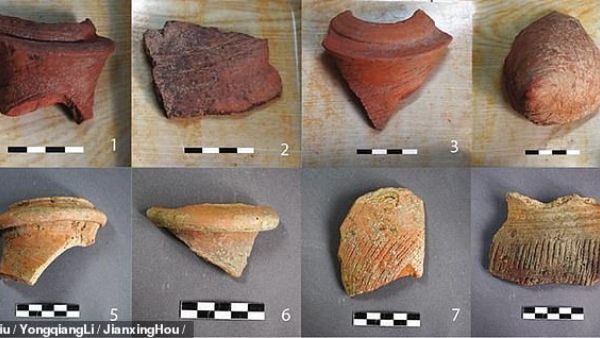Ancient Chinese people were working hard to create the perfect recipe for making beer 6,000 years ago, scientists reveal.
Nine Neolithic amphorae shards - used for transporting beer, wine and grain - were studied by researchers at Stanford University.
They found remnants of prehistoric beer as well as evidence of two clear methods used to brew the alcohol.
The methods were carried out separately and could have been combined to make different varieties of alcohol.
One method, employed by the Yangshao people in Dingcun, was to use malts made of sprouted millet, grass seeds and rice to produce low-alcohol drinks.
Whereas another made use of qu, mouldy grass and grains, to produce stronger drinks.
'Yangshao people may have been experimenting with various methods to find the best way for alcohol making, or were brewing multiple types of alcohol for different purposes,' Dr Liu Li, writes in the study.
Millennia later, the two techniques were recorded into literature, with the booze made from cereal known as li alcohol while the higher concentration drink was dubbed jiu.
Amphorae were produced in huge numbers in Neolithic China and were manufactured to be up to three feet (one metre) tall.
Dr Liu believes the growing popularity of amphorae in China is one of the Yangshao culture's most significant types of artefacts.
It served a core role in their culture, and researchers believe this may because it was used to produce alcohol.
The researchers write: 'The spread of amphorae may also indicate diffusion of beer-making techniques.
'It is notable that the size of amphorae increased over time, with many measuring nearly one meter in height during the Miaodigou phase, suggesting a growing demand for alcohol, probably for communal drinking rituals.'
The Miaodigou phase was a period of time around 6,000 years ago which saw a huge expansion of Yangshao's material production, including amphorae.
The cause of its expansion is unknown, but it is thought it helped facilitate the spread of beer-brewing technology.
Nine amphora shards were analysed as part of the study after being carefully washed.
'Alcohol production is one of the most significant inventions in human history, but archaeologists have encountered many challenges in their efforts to detect ancient fermentation technologies,' the authors write in the study,published in the Journal of Archaeological Science: Reports.
This article has been adapted from its original source.








